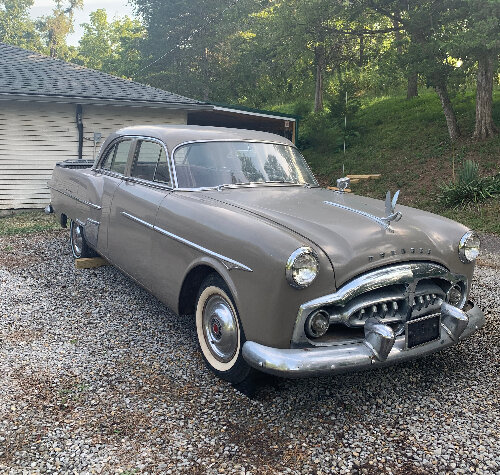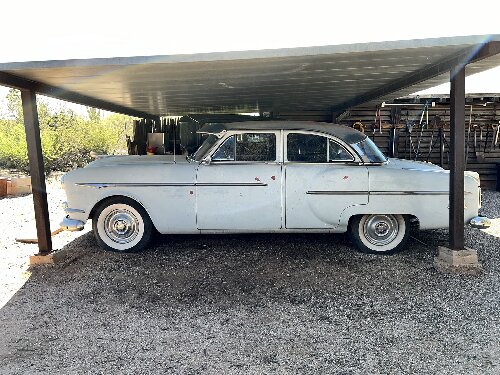|
Re: Power Window Modern Conversion
|
||||
|---|---|---|---|---|
|
Home away from home

|
(continued from 1st post)
The first challenge results from bench testing the Autoloc regulator (they call it a "track" with "lift") and their Bosch motor to see how the wiring and motion compares to the Packard regulator and motor. Aarg! They are NOT the same! The Packard motor wiring uses the regulator and door as electrical ground. If one touches either of the two motor wires with a hot lead (12V POS in my case since I converted my Pat to negative ground right after I bought it), the regulator arm moves in one direction. If you touch the other motor wire with the same hot lead, the regulator arm moves in the other direction. BTW, this explains why the power windows are NOT affected by changing from POS to NEG ground. The Autoloc (Bosch) motor also has 2 wires, but when tested the same way as the Packard (above), NOTHING HAPPENS. However, if you connect one wire to POS and the other wire to NEG, the regulator lift moves in one direction. If you reverse the connection, the regulator lift moves in the other direction. This is a problem because the Packard 4-switch only supplies the "hot" side (POS in my case) to either wire and does NOT change polarity. There are several solutions to this polarity-reversal problem. Autoloc (and others) sells switches that are DPDT with the contacts reverse wired, but these switches do not fit the Packard 4-switch and don't the look the same anyway. I wanted to retain the original 4-switch on the driver's door, so I devised a dual relay wiring solution. Here's one of the Omron "LY1" terminal connection diagram:  I used these Omron "LY1" cube relays and brackets because I had 4 new ones left over from another project, which is exactly how many I needed for both front doors. Any other equivalent relay would work as well. Here's the relay wiring schematic:  I used dual relays to avoid a momentary short problem when using just one relay. By using the 2nd relay to supply voltage to the "powered" relay terminals, I utilized the slight delay inherent in the relay coil and contacts closing to avoid the momentatry short. Here are the dual relays wired as above:  (continued next post)
Posted on: 2014/6/10 15:03
|
|||
|
Nuke them from orbit, it's the only way to be sure! Ellen Ripley "Aliens"
Time flies like an arrow. Frui |
||||
|
||||
|
Re: Power Window Modern Conversion
|
||||
|---|---|---|---|---|
|
Home away from home

|
(continued from 2nd post)
The next few challenges have to do with the physical installation. First, one must remove the "lower channel" from the window glass, which has the regulator stud slider slot attached to it. I doubt you can get this off with a rubber mallet and block of wood without breaking the glass. Instead, I used a handheld pneumatic cut-off tool to remove the slider slot (to gain access to the bottom of the lower channel metal) and then cut a deep groove across the entire length of the bottom of the lower channel. This allows one to pry one lower channel side away from the glass without breaking the glass. The result (after cleanup) is a bare, unbroken window glass.    (see next post)
Posted on: 2014/6/10 15:15
|
|||
|
Nuke them from orbit, it's the only way to be sure! Ellen Ripley "Aliens"
Time flies like an arrow. Frui |
||||
|
||||
|
Re: Power Window Modern Conversion
|
||||
|---|---|---|---|---|
|
Home away from home

|
(continued from 3rd post)
Next one must cut off some of the Autoloc track. I cut at one inch beyond the next to last threaded hole. Here's a picture of an original track and the one I cut. The purpose of this is get the top of the track under the top lip of the door while allowing sufficient lift movement to fully open and close the window glass.  The lift bar is supplied with a couple of rubber "boots" to fit between the glass and the metal of the lift bar. It turned out that I needed to shim the glass up about 1/2IN to get the glass fully "UP" without having the lift bar being too high (see picture). I used a couple of pieces of wood cut to fit for the shims since they won't hurt the glass and they won't compress later either.  (see next post)
Posted on: 2014/6/10 15:24
|
|||
|
Nuke them from orbit, it's the only way to be sure! Ellen Ripley "Aliens"
Time flies like an arrow. Frui |
||||
|
||||
|
Re: Power Window Modern Conversion
|
||||
|---|---|---|---|---|
|
Home away from home

|
(continued from post 4)
Next one must position the track and motor so that the lift bar and track is centered on the window glass. Conveniently, the forward most lip of the rearmost access hole in the front door can be used for one side of the mounting bracket in the correct position. Drill a couple of mounting holes along the lip at the positions shown in the picture. A "measure twice and drill once" procedure should be used to assure that the window glass both goes all the way up and down. I didn't get it exactly right the first time, but I just ended up with a couple of extra holes (see picture). In addition, I had to use another wood shim between the inner door metal and the motor mount to get the track exactly lined up vertically with the window frame rails (see picture). The top of the track also required shimming (see pic of spare slightly larger nut which acted as a shim). Because of this shimming, I went to the local Home Depot and bought 6 ea longer 6MM hex bolts (3 each door, see pic) to account for the shim width..  For the other side of the motor mount, I used some "metal plumber's tape" which conveniently bridges the hole in the rearmost access hole on the inner door panel. This is a straight forward fitment (see pic) of measuring and drilling. I had to supply the bolts/nuts/lock washers to attach the "metal plumber's tape" to the inner door metal, but used the hardware supplied in the kit for the motor mount frame.  The Autoloc track and motor frame are now permanently attached and there is no binding or misalignment. Using the same bench test voltage supply, the Autoloc Bosch motor causes the window glass to go up and down smoothly in it's guide tracks. (see next post)
Posted on: 2014/6/10 15:28
|
|||
|
Nuke them from orbit, it's the only way to be sure! Ellen Ripley "Aliens"
Time flies like an arrow. Frui |
||||
|
||||
|
Re: Power Window Modern Conversion
|
||||
|---|---|---|---|---|
|
Home away from home

|
(continued from post 5)
Next, I mounted the dual relays and their associated wiring using "metal plumber's tape" to bridge the gap in the forwardmost access hole in the door inner metal panel. This is more "measure and drill". I used short 10-32 bolts/nuts to attach the Omron LY1 brackets to the "metal plumber's tape" holes. Since I didn't happen to have any lock nuts for them, I used "Blue Loctite" on the threads instead. The top and bottom were secured with the same hardware used on the rearmost hole. I did secure the power lead from the motor to one of the relays to one of the tapes using a tight fitting clamp. This takes the strain off the mechanical/electrical connection at the relay. I also attached the ground lead to one of the tape attachment bolts.  (see next post)
Posted on: 2014/6/10 15:40
|
|||
|
Nuke them from orbit, it's the only way to be sure! Ellen Ripley "Aliens"
Time flies like an arrow. Frui |
||||
|
||||
|
Re: Power Window Modern Conversion
|
||||
|---|---|---|---|---|
|
Home away from home

|
Lastly, I connected the power leads to the 4-switch using mated (female-male & male-female) connectors. I tested window powered operation using my Pat's battery through the ignition switch (like normal). It works perfectly!
 I'll do the passenger side next as it's motor has about given up too. The window glass is cracked, but I have a spare that I will use. All is starting to get well with the (Packard) world again! (last initial series of posts). Craig
Posted on: 2014/6/10 15:43
|
|||
|
Nuke them from orbit, it's the only way to be sure! Ellen Ripley "Aliens"
Time flies like an arrow. Frui |
||||
|
||||
|
Re: Power Window Modern Conversion
|
||||
|---|---|---|---|---|
|
Forum Ambassador
|
Looks like a workable solution since we never heard back from anyone re the Jaguar motor or any other motor that was supposed to be a bolt in or easy repair option.
Since the old regulator had a spring to assist with the lift does this one have something and what kind of material is the track or lift tape. Just wondering if that is something that might be an issue with stripping or wearing. The old motors couldn't take much extra load past a perfectly functioning window and if one of the felts inside the channel bunches up or loosens and there is a bind, will that be an issue or can this regulator/motor do better.
Posted on: 2014/6/10 16:12
|
|||
|
Howard
|
||||
|
||||
|
Re: Power Window Modern Conversion
|
||||
|---|---|---|---|---|
|
Home away from home

|
Craig,
What exactly did you fix on the OEM motors? What fails, that causes you to replace them?
Posted on: 2014/6/10 20:10
|
|||
|
||||
|
Re: Power Window Modern Conversion
|
||||
|---|---|---|---|---|
|
Home away from home

|
HH56 Quote:
Since the old regulator had a spring to assist with the lift ...(snip) Howard, I don't know...only time and a lot of use will tell. The whole Autoloc kit looks very robust, so my "gut engineering" side says it will be OK. Craig
Posted on: 2014/6/11 0:22
|
|||
|
Nuke them from orbit, it's the only way to be sure! Ellen Ripley "Aliens"
Time flies like an arrow. Frui |
||||
|
||||








